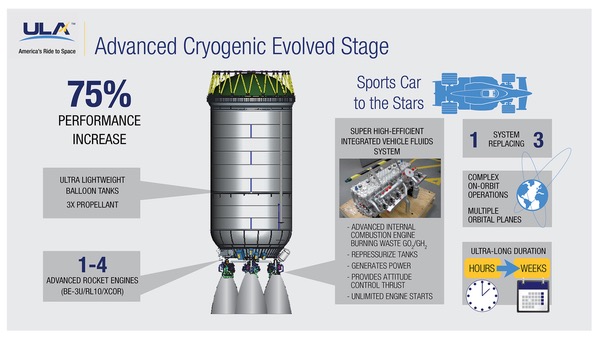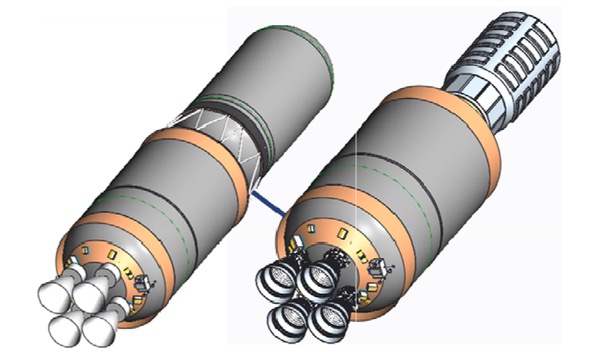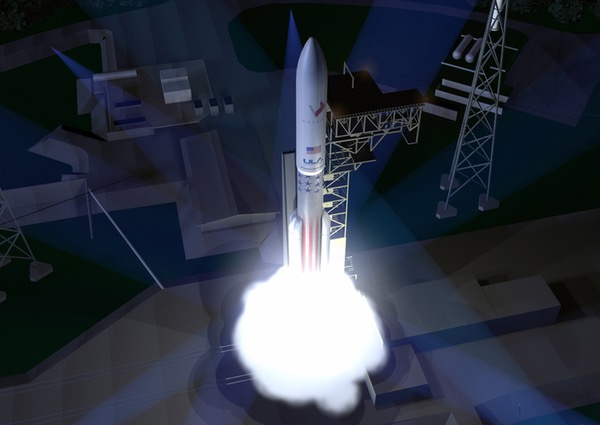Vulcan’s futureby Jeff Foust
|
| “We have a bunch of engines in play,” Barr said of the ACES upper stage. “We think we’re headed towards a competitive engine downselect out in the future here.” |
Vulcan, though, is more than just about ending dependence on a Russian engine. ULA has laid out a long-term strategy for upgrading the Vulcan, including the development of a new upper stage, partial reusability, and other concepts to enable heavier payloads and reduce costs, ideas ULA officials discussed at the recent AIAA Space 2015 conference in Pasadena, California. But a proposal last week by another company to acquire ULA could put those plans in question.
 A ULA infographic about its ACES upper stage. (credit: ULA) |
ACES in the hole
When Vulcan first flies at the end of the decade, it will use the existing Centaur upper stage. However, ULA has plans to replace the venerable Centaur, whose heritage dates back to the 1960s, with a new, and more powerful, upper stage, called the Advanced Common Evolved Stage (ACES).
“The first step is coming, which is the Vulcan. Mine is the second step, which is the ACES,” said Jonathan Barr of ULA in an August 31 presentation of a paper about ACES at the conference.
ACES will be larger than the Centaur and more powerful, with the equivalent thrust of four RL10 engines; the Centaur, by contrast, uses only a single RL10 on Atlas launches today. ACES will have a larger diameter than the Centaur, but with the same length, which Barr said would limit changes to launch facilities once ACES replaces the Centaur.
ULA has not yet settled on the engine that ACES will use. “We have a bunch of engines in play,” Barr said, including not just the RL10 but also Blue Origin’s BE-3 engine and one being developed by XCOR Aerospace in cooperation with ULA. “There are still other possible engines being discussed out there,” he added, without naming them.
Barr hinted that ULA may be ready to select an engine in the near future. “We think we’re headed towards a competitive engine downselect out in the future here,” he said, but didn’t give a timeline for that decision.
One major innovation of ACES is a technology called integrated vehicle fluids. It uses hydrogen and oxygen boiloff from the stage’s propellant tanks to fuel an auxiliary power unit. “It’s kind of like an Honda generator in space,” he said. That technology eliminates the need for most or all batteries to power the stage, and also pressurizes the propellant tanks, eliminating the need to carry helium bottles for that task.
That, he said, makes the stage simpler and less expensive, and also improves its performance by eliminating the mass those batteries and helium tanks needed. “I suddenly get a thousand pounds plus performance benefit on a GEO mission,” he said.
ULA’s current plans call for introducing ACES in 2023, about four years after the Vulcan’s first launch.
(Partial) reusability
Long before ULA announced the Vulcan, the company was exploring ways to incorporate reusability into its launch vehicles. The company presented concepts on recovering and reusing Atlas V first stage engines at AIAA Space several years ago, and ULA president and CEO Tory Bruno hinted that this concept might be incorporated into its next-generation vehicle two months before unveiling the Vulcan (see “Reusability revival”, The Space Review, February 16, 2015).
| “With SMART reuse, at about two launches you break even,” Ragab said, according to ULA’s cost modeling. “With the booster flyback option, it takes about ten flights until you start making money.” |
That concept, called Sensible Modular Autonomous Return Technology (SMART), will be incorporated in the Vulcan around the mid-2020s, according to the company’s roadmap. Unlike SpaceX, which is attempting to land and reuse the entire first stage of its Falcon 9, SMARY involves the recovery of only the Vulcan’s first-stage engines.
The engine-only recovery, explained ULA’s Mohamed Ragab in a paper presentation at AIAA Space August 31, is based on economics. The engine accounts for less than a quarter of the dry mass of the first stage, but about 60 percent of its cost. “With SMART reuse, at about two launches you break even,” he said, according to ULA’s cost modeling. “With the booster flyback option, it takes about ten flights until you start making money.”
In the SMART approach, the engine module will separate from the Vulcan’s first stage and deploy an inflatable aerodynamic decelerator to slow it down, based on technology developed at NASA. A parachute would later slow down the engines, allowing for mid-air capture.
Ragab said he expected SpaceX would succeed in landing a stage on a ship or on land. “But once you get it, you’re going to see the state of the hardware, and you’re going to find out over time how many times you can use it,” he said. If the stage can’t be reused that much, and with the significant performance hit imposed by flying back the booster, “it’s not going to work.”
Ragab said he wasn’t concerned about the reusability of the BE-4 engine currently planned for the Vulcan. Blue Origin, he said, is planning on reusing the BE-4 “for its own uses,” a reference to Blue Origin’s plans to develop its own reusable launch vehicle. He declined, though, to say how many flights the engine was rated for, saying that information was proprietary.
 In distributed launch, one ACES upper stage, equipped with a drop tank (left) refuels another carrying a payload, increasing the mass of payloads that can be launched beyond low Earth orbit. (credit: ULA) |
A kind of propellant depot
ULA is also looking at how the ACES upper stage can be used to launch even heavier payloads than possible on a single mission. A concept called “distributed launch” being studied by ULA would allow two launches to send payloads beyond Earth orbit that are too heavy to be accommodated on a single launch.
In distributed launch, as explained by ULA’s Bernard Kutter in a September 1 paper presentation at AIAA Space, the first launch would place into low Earth orbit only propellant, carried in the ACES stage and an attached drop tank. A second launch would place into orbit an ACES stage and its payload. The two stages would rendezvous, and the first ACES would transfer propellants into the second ACES. The second ACES would fire its engines to send its payload to geostationary orbit or beyond.
Some systems being developed for ACES, like integrated vehicle fluids, make it ideal for distributed launch: the stage is powered by boiloff from its tanks, so it can operate almost indefinitely without worrying about batteries. The stage, though, will need systems to limit the amount of propellant lost to boiloff during the weeks that it waits for the second launch, but ULA has been working on those technologies, as well as for cryogenic fluid transfer.
| “Making money in space—and I can speak from many years of experience—is a very difficult problem,” said Sowers. “But solving that is one I feel we absolutely must do if humans are going to establish a permanent presence in outer space.” |
Distributed launch, Kutter explained, can place payloads into geostationary orbit or beyond Earth orbit much heavier than if launched individually. A single Vulcan rocket with an ACES upper stage can place payloads directly into geostationary orbit (rather than the more commonly used geostationary transfer orbit) weighing up to 8 metric tons. Using distributed launch, two Vulcan/ACES launches can place up to 20 metric tons into the same orbit.
At the conference, some asked if distributed launch might be a precursor to a full-fledged propellant depot. “The easy answer is yes,” Kutter responded. “Distributed launch is trying to bypass the fear people have of emplaced infrastructure” since the initial ACES stage and drop tank are used only once.
Expanding distributed launch to something more permanent would likely involve only modest changes to the ACES design, such as the addition of shielding to protect from micrometeoroids and orbital debris. “In the long term,” he said, “if I’m doing a lot of missions, more than one or two a year, something more permanent probably makes sense.”
Putting it all together
Individually, these technologies offer improvements in performance and cost. However, ULA is looking beyond these as ways to incrementally improve Vulcan’s performance but instead to change the economics of space access in general.
“Making money in space—and I can speak from many years of experience—is a very difficult problem,” said George Sowers, vice president of advanced concepts and technologies for ULA during a September 2 panel session. “But solving that is one I feel we absolutely must do if humans are going to establish a permanent presence in outer space.”
Sowers, in his presentation, proposed a system based on the ACES upper stage and a lander derived from it called Xeus, which ULA has been working on based on Centaur designs with Masten Space Systems. Both use liquid oxygen and liquid hydrogen propellants, which can be produced from water that is “widely available” beyond Earth, such as the Moon.
In that concept, Xeus would handle transportation from the surface of the Moon to the Earth-Moon L1 point. ACES could then operate from L1 to “any other location,” he said. He said that could lead to trade routes in cislunar space, avoiding the Earth’s gravity well inside of geostationary orbit except for specialized components and people.
Sowers gave a notional example in his talk of space-based solar power, a technology widely considered uneconomical now because of transportation costs. Developing those satellites with space resources, and using the transportation infrastructure enabled by ACES and Xeus, could make them much less expensive.
How much less expensive? Sowers said that a back-of-the-envelope calculation showed that the transportation cost for a solar power satellite in geostationary orbit is reduced by a factor of 3,000. That doesn’t take into account, he acknowledged, the infrastructure required to assemble and operate this system, but the large factors in transportation cost reductions could accommodate those costs. “Yes, there could be a self-sustaining economy fueled by energy in space,” he said. Once that’s in place, “everyone else’s business case starts to close.”
The AR wild card
All of that assumes that ULA remains on its current path for the next decade. But just in the last week, there are indications that ULA’s future as a joint venture of Boeing and Lockheed Martin may be up in the air.
| While ULA has selected Blue Origin’s BE-4, it seems an Aerojet-owned ULA would prefer its own AR1 engine. The same goes for the planned ACES upper stage, where the RL10 is more likely than either the BE-4 or XCOR’s engine. |
Last week, media reported that Aerojet Rocketdyne, the rocket engine manufacturer that counts ULA as among its customers, made a $2-billion bid for ULA to its corporate parents. None of the companies would confirm the bid on the record. “Wish I could, but as a matter of policy, we don’t comment on this type of story,” Bruno tweeted September 9, a day after the news broke.
While initial reports suggested a deal could be announced as soon as this week, at an Air Force conference in suburban Washington DC, more recent reports suggest any deal will take longer to consummate, given negotiations between Aerojet Rocketdyne and Boeing and Lockheed Martin, and discussions between Aerojet and the Air Force, the largest customer of ULA’s rockets.
If a deal does go through, it will likely mean some changes to the Vulcan design. Aerojet Rocketdyne has been developing its own rocket engine, the AR1, which it proposed as either a replacement for the Atlas V’s RD-180 or for the first stage of the Vulcan. While ULA has selected Blue Origin’s BE-4, it seems an Aerojet-owned ULA would prefer its own engine. The same goes for the planned ACES upper stage, where the RL10 is more likely than either the BE-4 or XCOR’s engine.
Other innovations, like SMART reusability and distributed launch, would not be as directly affected by an acquisition. However, the changes instituted by such a deal could cause them to be delayed or indefinitely deferred, depending on the priorities of the company’s new ownership. That promise of a cislunar economy powered by ACES stages and Xeus landers remains, for now, just a promise.
